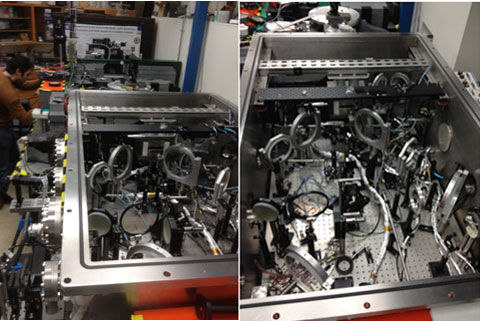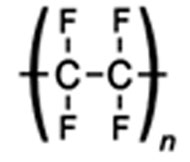Tiny Particle Accelerators
July 30, 2013
The world’s most famous particle accelerators require miles of underground tunnels and billions of dollars to build. So how have scientists now produced some tiny accelerators in the lab? With some of the world’s most powerful lasers!
Stanford Linear Accelerator Center (SLAC) is 2 miles (3.2 km) long. CERNs former Large Electron Positron (LEP) collider, which was reconstructed to a Large Hadron Collider (LHC), has a circumference of 17 miles (27 km). SLAC has the ability to accelerate electrons and positrons to energies of 50 GeV.
With the advent of the ultrafast lasers, scientist can produce electrons with ultra relativistic speeds, and accelerated electron-positron pairs on a table in a lab!1,2

Left: The lab room where one of the experiments was carried out. Right: a closer view of the lab table (optical bench) it was performed on. Note that the optical bench is set-up for a different experiment.
Image Credit: Dr. G. Sarri/Center for Ultrafast Optical Science/Univ. of Michigan
Powerful Lasers, Speedy Electrons
In June 2013, two different research articles were published on table-top accelerators.1,2 The first was by a multi-national team of scientists who created ultra relativistic electrons of 200 MeV. The ultra-relativistic electrons produced electron and positron beams on the order of 80 to 140 MeV.1
The second research group, from the University of Texas at Austin, created ultra-relativistic electrons with energies of 2 GeV, and measured the X-rays produced by these fast electrons.2 The Texas group had the more powerful laser.
The first, multi-national group of scientists employed the HERCULES laser at the University of Michigan. They used a laser pulse of energy 0.8 joules (J) that lasted 30×10-15 seconds, which gives it a power of about 27 TW (terawatts) or 27×1012 W. The laser has a frequency of 3.75E14 Hz.1
This may not seem like a lot of energy, only 0.8 J, but the real point of power is how fast you can deliver that energy. This energy comes from just one pulse.
An incandescent 100 W light bulb converts 100 J of electrical energy every second (and less than 5% of that is converted to visible light energy). Consider collecting the 0.8 J light pulses to get one second of “on” time for the HERCULES laser.
For a total of one second, it would deliver about 27 trillion joules (27,000,000,000,000 J).1 It is capable of delivering up to half a quadrillion joules each second. The laser in Austin, TX had a power of 1 PW (petawatt) or 1× 1015 W. It is capable of delivering 1 quadrillion joules per second (1,000,000,000,000,000 J/s).2
The laser pulse from HERCULES is focused (using a parabolic mirror) on a helium gas jet that is doped with nitrogen. The laser pulse completely ionizes (separates all electrons from all nuclei) ALL the gas molecules. This substance of bare nuclei and electrons is called a plasma. In this plasma, there are roughly 9×1018 electrons per cubic centimeter (or 9000 quadrillion electrons per cubic centimeter).
These electrons then get accelerated to very high speeds by the forward moving laser pulse. The maximum amount of kinetic energy (energy of motion) they obtain is about 200 MeV, this is ultra-relativistic, meaning their speed is close to the speed of light. How close? About 0.9999967526 times the speed of light.
The Texas group achieved ultra relativistic electrons in a similar way. Their laser was more powerful, so they achieved electron energies of up to 2 GeV, which means the electrons were moving at speeds even closer to the speed of light.
Diverging Paths
Despite similar setups, the two groups were chasing two different things.
The accelerating electrons (as they were speeding up) produce X-rays. The experiment of the Texas group measured the ultra-relativistic electrons and the X-rays produced.
However, the multi-national group were not interested in the X-rays. Their goal was to produce some energetic electron and positron beams. Positrons are the antimatter analog of electrons. They have all the same characteristics of an electron except they are positively charged and have an opposite magnetic moment. When an electron and positron collide, they annihilate each other, producing two gamma photons — very high frequency electromagnetic energy packets.
In the multi-national team’s experiment, the ultra relativistic electron beam strikes a block of Teflon. The Teflon stops the electrons below 1 MeV and stops the X-rays that would arise.

A Teflon molecule
The Teflon has a very low atomic number (number of protons in the molecule), so a secondary type of radiation known as braking radiation or bremsstrahlung radiation is negligible. Bremsstrahlung radiation occurs as the electron is deflected by the electric field of an atomic nucleus.
After passing through the Teflon, the ultra relativistic electrons interact with what is called a high Z target. High Z materials have a large number of protons per atom, like lead (Pb). The ultra relativistic electrons slow down as they interact with the atomic nuclei, producing bremsstrahlung radiation that then interacts with the nucleus and produces an electron-positron pair. This is known as a two-step process.
The trident process, another process producing electron-positron pairs, occurs but does not produce nearly as many electron-positron pairs as the two-step process. In the trident process an ultra relativistic electron interacts directly with a nucleus resulting in the production of an electron-positron pair. All the produced electron-positron pairs carry the forward motion of the original electrons.
The electron-positron pairs leave the high Z material and are separated by a magnetic field and then measured. The magnetic field forces the positively charged positron one way and the negatively charged electron the other, separating them into two forward moving beams.
Here’s the setup the team used.

Figure showing the multi-national team’s set-up at the University of Michigan.
(a) The peta laser called HERCULES emits a powerful pulse that completed ionizes a jet of helium gas doped with nitrogen. This creates a plasma with 900 quadrillion electrons per cubic centimeter. These electrons are accelerated by the laser pulse and strike a piece of Teflon (not shown) that removes the slower electrons and any X-rays produced.
(b) The faster electrons interact with a high Z material producing fast, forward moving electron-positron pairs. The electrons and positrons are separated by a magnetic field and measured.
Image Credit: Dr. G. Sarri
The high Z materials the scientists tried out were copper (Cu), selenium (Sn), tantalum (Ta), and lead (Pb). The scientists measured energy significantly above noise level between 80 and 140 MeV, with a maximum density of positrons around 90 to 100 MeV for lead and tantalum.
If this group were to use the Texas laser, and the 2 GeV electron beam were to impact the high Z target, they would expect to get positrons with a peak energy of about 1.5 GeV.
Future research and development
Scientists believe that the generation of ultra relativistic positron beams could be used to build models in the lab to study propagation of astrophysical jets in the interstellar medium, to build electron positron colliders in the lab, and to further study matter and antimatter.1
References and Resources
1. Sarri, G. et al., Table-Top Laser-Based Source of Femtosecond, Collimated, Ultrarelativistic Positron Beams, Phys. Rev. Lett. 110, 255002 (2013).http://prl.aps.org/abstract/PRL/v110/i25/e255002
2. Wang, X. et al., Quasi-monoenergetic laser-plasma acceleration of electrons to 2 GeV, Nat. Commun. 4, 1988 (2013)
http://www.nature.com/ncomms/2013/130611/ncomms2988/full/ncomms2988.html
3. For a discussion on positron production: Meissner, C., Mass-Producing Positrons, Lawrence Livermore National Laboratory, (2009)
https://str.llnl.gov/JulAug09/pdfs/07.09.3.pdf
—Heide Doss














